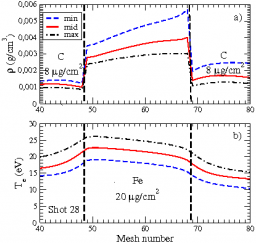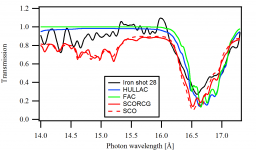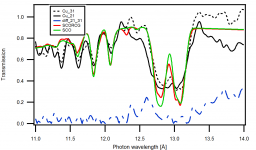
Figure 1. Hydrodynamic simulation of a sample of iron with an areal mass of 20 µg/cm2. Density (a) and temperature (b) profiles as functions of the Lagrangian coordinates. The "mid" curves correspond to the results of measurements of radiative temperature given by μ DMX. The "max" and "min" curves show estimates corresponding to the μ DMX measurements shifted by one standard deviation.
Authors :
T. Blenski, G. Loisel, M. Poirier, F. Thais, CEA DSM/IRAMIS
P. Arnault, T. Caillaud, J. Fariaut, F. Gilleron, J.-C. Pain, Q. Porcherot, C. Reverdin, V. Silvert, B. Villette, CEA-DAM
S. Bastiani-Ceccotti, LULI-École Polytechnique
S. Turck-Chièze, CEA-DSM/IRFU
W. Fölsner, MPQ Munich
F. de Gaufridy de Dortan, UPM Madrid
Summary : In the spectral region of 2p-nd transitions with n ≥ 3, the plasmas opacities of elements with neighboring atomic number Z are measured and analyzed using several atomic physics codes. Hydrodynamic simulations based on measures of radiative temperature performed using the μ‑DMX spectrometer allowed us to estimate sample temperatures and densities. The samples were heated by thermal radiation in cavities irradiated by LULI‑2000 nanosecond laser. The probe X-rays gold backlighter radiation was created using the LULI PICO‑2000 beam. Comparisons of theoretical transmission with measurements tallow us to validate the models used in opacity codes in some cases of interest and to clarify a number of important effects in the modeling, as the thermal broadening of the absorption structures, spin-orbit separation and interaction of relativistic configurations.
Measurements of opacity in plasmas of with neighboring Z, iron (Z=26), nickel (28), copper (29) and germanium (32) were performed at the LULI‑2000 facility. The analyzed spectral region corresponds to the electronic transitions 2p‑nd, n ≥ 3. The radiative temperatures in the cavity, measured with the μ‑DMX wide-band spectrometer 1] were used as a starting point for hydro-radiative simulations (Fig. 1). The temperatures of the samples are around 20 eV and the densities of the order of 0.01 g/cm3. According to our theoretical predictions, the splitting of the 2p‑3d structures, due to spin-orbit coupling, invisible in the case of iron, should gradually appear with increasing Z. In addition, the 2p‑3d structures are sensitive to the relativistic configuration interaction (RCI). Measured transitions were compared [1,2] with theoretical results obtained from the statistical opacity code SCO [3], the detailed codes HULLAC [4] and FAC [5], and the new mixed code SCO-RCG [6]. Although approximate in the description of the absorption structures, the SCO code allows one to take into account a large number of excited electronic states as well as the screening due to free plasma electrons. The HULLAC and FAC codes are based on detailed calculations of lines, but even for medium Z elements they become often prohibitive due to the presence of too many atomic states, the complexity of electronic structures and the limitation of computation time. The SCORCG code, recently developed at the CEA - DAM Île-de-France, has a mixed nature : based on the SCO code and the Cowan's RCG code [7], it allows one to perform detailed calculation of chosen transition arrays involving a reasonable number of lines from relevant configurations, treating the lines from remaining configurations in a statistical way.

Figure 2.Comparison of the measured transmission of an iron sample with the areal mass of 20 µg / cm2 with the transmissions obtained from four different codes (temperature of 22 eV and a density of 4 mg/cm3). The 2p- nd transitions with n> 3 are not taken into account in the detailed calculations performed using HULLAC and FAC.

Figure 3. Comparison of the two measured transmissions of a copper plasma sample with an areal mass of 40 µg / cm2 with the transmissions computed using the statistical code SCO and the mixed code SCORCG (temperature of 16 eV and density of 5 mg/cm3). The energy of the heating laser shot had 64 J energy in the case 31 of the spectrum markedlabeled “Cu_31” and 80 J in the case of “Cu_21”. The difference between the two experimental transmissions is also plotted (, “diff_21_31”).
As an example, we present here two comparisons between theory and experiment : the first one concerns an iron plasma, important element in astrophysics, and the second one a copper plasma (copper is sometimes used some inertial fusion ablators).
In the case of iron (Fig. 2), the shape of the 2p‑3d absorption structures (between 16 and 17.5 Å) is qualitatively rather well reproduced by the codes but the theoretical transmission are lower than those measured. The spin-orbit separation of the 2p‑3d structures disappears due to thermal effects, both in the measured and theoretical transmissions. Indeed, the calculations revealed that the broadening of the 2p‑3d structures of iron results mostly from the thermal fluctuation of the number of electrons in the 3p sub-shell of the plasma ions. The transmission due to the 2p‑nd transitions with n>3, relatively high, is probably exposed to statistical noise in the measured spectrum (from 13 to 15.5 Å) and the theory-experiment agreement is practically nonexistent in this spectral range.
In the case of copper plasma (Fig. 3), the agreement between theoretical and experimental values is better than for the iron plasma. The spin-orbit splitting of the 2p‑3d structures (between 12.5 and 13.5 Å) is clearly visible, in agreement with calculations. The effect of RCI has also been observed: The theoretical transmission obtained using the SCORCG code which includes the RCI in an exact way improves the agreement with the experimental curve with respect to SCO which treats the RCI in an approximate way. The analysis of spectra calculated in the case of copper reveals that the 3p subshell is here closed and the broadening of the 2p‑3d structures is mainly due to the presence of a large number of lines connected to the occupation of 3d subshell which fluctuates around 5, i.e., half of its maximum value. A relatively good agreement between theory and experiment is also observed in the wavelength range of the 2p‑nd transitions with n>3. These and other published comparisons [1,2] have shown that the statistical and detailed codes are able to reproduce the measured transmissions in the 2p‑3d spectral region. The positions of the 2p-3d structures, very sensitive to temperature, can also serve as an additional diagnosis of temperature, for example, when measuring opacities in the XUV domain, corresponding to Δn = 0 transitions, which are important in astrophysics and to some extent in inertial fusion.
References
[1] T. Blenski, G. Loisel, M. Poirier, F. Thais, P. Arnault, T. Caillaud, J. Fariaut, F. Gilleron, J.-C. Pain, Q. Porcherot, C. Reverdin, V. Silvert, B. Villette, S. Bastiani-Ceccotti, S. Turck-Chièze, W. Foelsner, F. De Gaufridy De Dortan, “Opacity of iron, nickel, and copper plasmas in the x-ray wavelength range: Theoretical interpretation of 2p-3d absorption spectra”, Phys. Rev. E, 84, 036407 (2011).
[2] T. Blenski, G. Loisel, M. Poirier, F. Thais, P. Arnault, T. Caillaud, J. Fariaut, F. Gilleron, J.-C. Pain, Q. Porcherot, C. Reverdin, V. Silvert, B. Villette, S. Bastiani-Ceccotti, S. Turck-Chièze, W. Foelsner, F. De Gaufridy De Dortan, “Theoretical interpretation of x-rays photo-absorption in medium-Z elements plasmas measured at LULI2000 facility”, High Energy Density Phys., 7, p. 320-326 (2011).
[4] A. Bar-Shalom, M. Klapisch, J. Oreg, “HULLAC, an integrated computer package for atomic processes in plasmas”, J. Quant. Spectrosc. Radiat. Transfer, 71, p. 169-188 (2001).
[5] M. F. Gu, “The flexible atomic code”, Can. J. Phys., 86, p. 675-689 (2008).
[6] Q. Porcherot, J.-C. Pain, F. Gilleron, T. Blenski, “A consistent approach for mixed detailed and statistical calculation of opacities in hot plasmas”, High Energy Density Phys., 7, p. 234-239 (2011).
[7] R. D. Cowan, The theory of atomic structure and spectra, University of California, Berkeley (1981).











